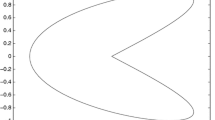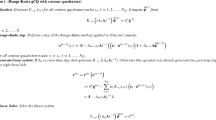Abstract
The usual time domain Boundary Element Method (BEM) contains fundamentalsolutions which are convoluted with time-dependent boundary data andintegrated over the boundary surface. Here, a new approach for theevaluation of the convolution integrals, the so-called ’OperationalQuadrature Methods‘ developed by Lubich, is presented. In thisformulation, the convolution integral is numerically approximated by aquadrature formula whose weights are determined using the Laplacetransform of the fundamental solution and a linear multisep method. Tostudy the behaviour of the method, the numerical convolution of afundamental solution with a unit step function is compared with theanalytical result. Then, a time domain Boundary Element formulationapplying the ’Operational Quadrature Methods‘ is derived. For thisformulation only the fundamental solutions in Laplace domain arenecessary. The properties of the new formulation are studied with anumerical example.
Similar content being viewed by others
References
Ahmad, S. and Manolis, G.D.,‘Dynamic analysis of 3-d structures by a transformed boundary element method’, Computational Mechanics, 2(1987) 185–196.
Antes, H., Anwendungen der Methode der Randelemente in der Elastodynamik und der Fluiddynamik, Mathematische Methoden in der Technik 9, B. G. Teubner, Stuttgart, 1988.
Bonnet, M., ‘Regular boundary integral equations for three-dimensional finite or infinite bodies with and without curved cracks in elastodynamics', in Brebbia, C.A., Zamani, N.G., (Eds.), Boundary Element Techniques: Applications in Engineering, Southampton, Computational Mechanics Publications, 1989.
Graff, K. F., Wave Motion in Elastic Solids, Oxford University Press, 1975.
Guiggiani, M. and Gigante, A., ‘A general algorithm for multidimensional cauchy principal value integrals in the boundary element method’, ASME Journal of Applied Mechanics, 57(1990) 906–915.
Jäger, M., Entwicklung eines effizienten Randelementverfahrens für bewegte Schallquellen, Braunschweiger Schriften zur Mechanik 17-1994, Technische Universität Braunschweig, 1994.
Lubich, C., ‘Convolution quadrature and discretized operational calculus. I.’, Numerische Mathematik, 52 (1988) 129–145.
Lubich, C., ‘Convolution quadrature and discretized operational calculus. II.’, Numerische Mathematik, 52 (1988) 413–425.
Lubich, Ch., ‘On the multistep time dicretization of linear initial-boundary value problems and their boundary integral equations', Numerische Mathematik, 67(1994) 365–389.
Lubich, Ch. and Schneider, R., ‘Time discretization of parabolic boundary integral equations', Numerische Mathematik, 63(1992) 455–481.
Mansur, W. J., A Time-Stepping technique to solve wave propagation problems using the boundary Element Method, PhD thesis, University of Southampton, 1983.
Schanz, M., Eine Randelementformulierung im Zeitbereich mit verallgemeinerten viskoelastischen Stoffgesetzen, Bericht aus dem Institut A für Mechanik Heft 1, Universität Stuttgart, 1994.
Schanz, M., Gaul, L. and Antes, H., ‘Numerical damping and instability of a 3–d BEM time-stepping algorithm’, Extended Abstracts of IABEM 93, Braunschweig, 1993.
Steinfeld, B., Numerische Berechnung dreidimensionaler Kontaktprobleme Bauwerk-Boden mittels zeitabhängiger Randintegralgleichungen der Elastodynamik, Technisch wissenschaftliche Mitteilungen Nr. 93–1, Ruhr-Universität Bochum, 1993.
Wiebe, Th. and Antes, H., ‘A time domain integral formulation of dynamic poroelasticity’, Acta Mechanica, 90(1991) 125–137.
Author information
Authors and Affiliations
Rights and permissions
About this article
Cite this article
SCHANZ, M., ANTES, H. Application of ‘Operational Quadrature Methods’ in Time Domain Boundary Element Methods. Meccanica 32, 179–186 (1997). https://doi.org/10.1023/A:1004258205435
Issue Date:
DOI: https://doi.org/10.1023/A:1004258205435




